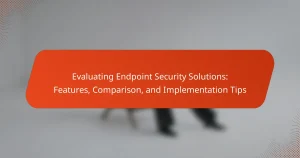Cloud security refers to the practice of safeguarding cloud computing environments, including data, applications, and services, from various threats. This article explores the significant risks associated with cloud security, such as data breaches, loss of data control, and account hijacking, highlighting the financial impact of these incidents. It also examines compliance standards, including ISO/IEC 27001, NIST SP 800-53, and GDPR, which guide organizations in maintaining data protection and regulatory adherence. Furthermore, the article outlines essential protection measures such as data encryption, access control, and regular security audits that enhance the security posture of cloud environments.
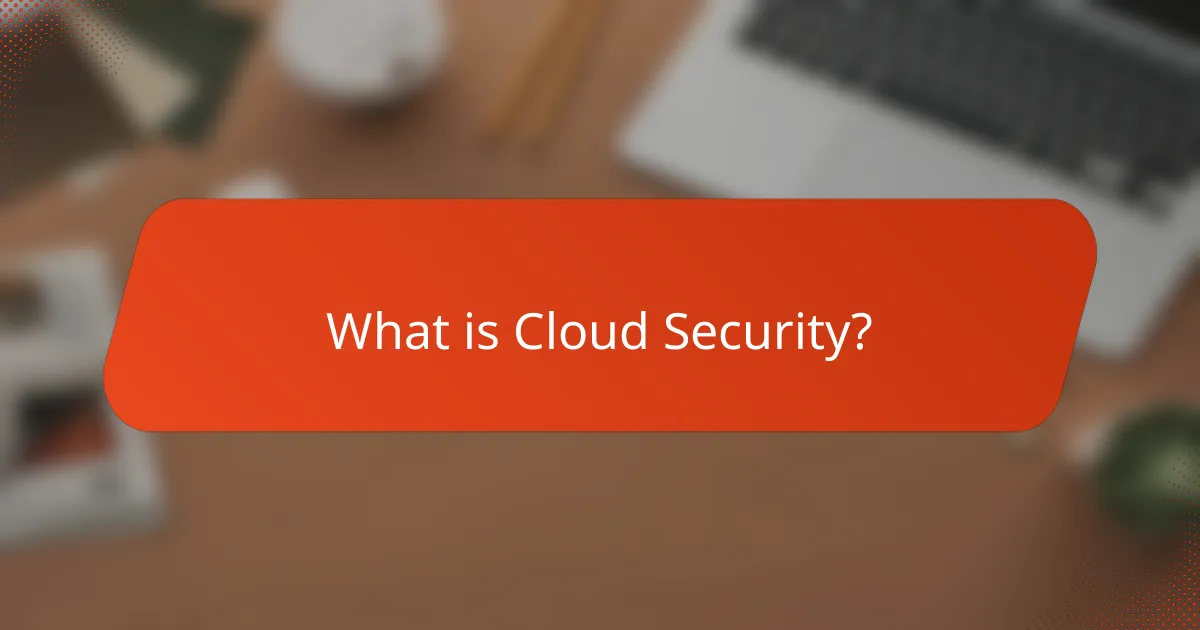
What is Cloud Security?
Cloud security is the practice of protecting cloud computing environments from threats. It involves safeguarding data, applications, and services hosted in the cloud. Cloud security measures include encryption, identity and access management, and security protocols. These measures help prevent unauthorized access and data breaches. According to a report by McAfee, 52% of organizations experienced a cloud security incident in 2020. This highlights the importance of implementing robust cloud security strategies. Effective cloud security ensures compliance with regulations and protects sensitive information.
Why is Cloud Security important for businesses?
Cloud security is crucial for businesses to protect sensitive data and ensure compliance. It safeguards against data breaches, which can lead to significant financial losses. In 2021, the average cost of a data breach was $4.24 million according to IBM. Cloud security also helps maintain customer trust, as clients expect their information to be secure. Additionally, regulatory compliance is essential; businesses face penalties for failing to protect personal data. Implementing robust cloud security measures can reduce risks associated with cyber threats. Overall, cloud security is vital for business continuity and reputation management.
What are the key threats to cloud security?
Key threats to cloud security include data breaches, account hijacking, and insecure APIs. Data breaches occur when unauthorized parties access sensitive information stored in the cloud. According to a 2021 report by IBM, the average cost of a data breach is $4.24 million. Account hijacking involves attackers gaining access to user accounts, potentially leading to data theft or service disruption. Insecure APIs can expose vulnerabilities, allowing attackers to exploit cloud services. Additionally, insider threats, such as employees misusing access, pose significant risks. A study by the Ponemon Institute found that 53% of organizations experienced insider threats in 2020. Lastly, denial-of-service attacks can overwhelm cloud services, rendering them unavailable to legitimate users.
How do cloud security measures protect sensitive data?
Cloud security measures protect sensitive data through encryption, access controls, and monitoring. Encryption transforms data into a secure format, making it unreadable without a decryption key. This ensures that even if data is intercepted, it remains protected. Access controls limit who can view or manipulate data. These controls include multi-factor authentication and role-based access. Monitoring involves tracking data access and usage patterns to detect anomalies. According to a report by Gartner, organizations that implement robust cloud security measures reduce the risk of data breaches by up to 60%.
What are the fundamental principles of cloud security?
The fundamental principles of cloud security include data protection, identity and access management, and compliance. Data protection ensures that sensitive information is encrypted and securely stored. Identity and access management controls who can access cloud resources and what actions they can perform. Compliance involves adhering to legal and regulatory requirements for data handling. These principles help mitigate risks associated with cloud computing. They are essential for maintaining the confidentiality, integrity, and availability of data in cloud environments. Effective implementation of these principles can significantly reduce the likelihood of data breaches and unauthorized access.
How does data encryption enhance cloud security?
Data encryption enhances cloud security by protecting sensitive information from unauthorized access. It transforms data into an unreadable format, requiring a decryption key for access. This process safeguards data both at rest and in transit. For example, encryption protocols like AES-256 are widely used for their robust security features. According to a study by the Ponemon Institute, 60% of organizations that implemented encryption reported a significant reduction in data breaches. Additionally, encryption helps organizations comply with regulations such as GDPR and HIPAA, which mandate data protection measures. Overall, encryption is a critical component of a comprehensive cloud security strategy.
What role do access controls play in cloud security?
Access controls are essential for cloud security. They regulate who can access resources and data in the cloud environment. By implementing access controls, organizations can restrict unauthorized users from gaining entry. This minimizes the risk of data breaches and ensures compliance with regulations. Access controls can include user authentication and role-based permissions. According to a 2020 report by the Cloud Security Alliance, 99% of cloud security failures are due to misconfigured access controls. Properly configured access controls protect sensitive information and maintain data integrity.
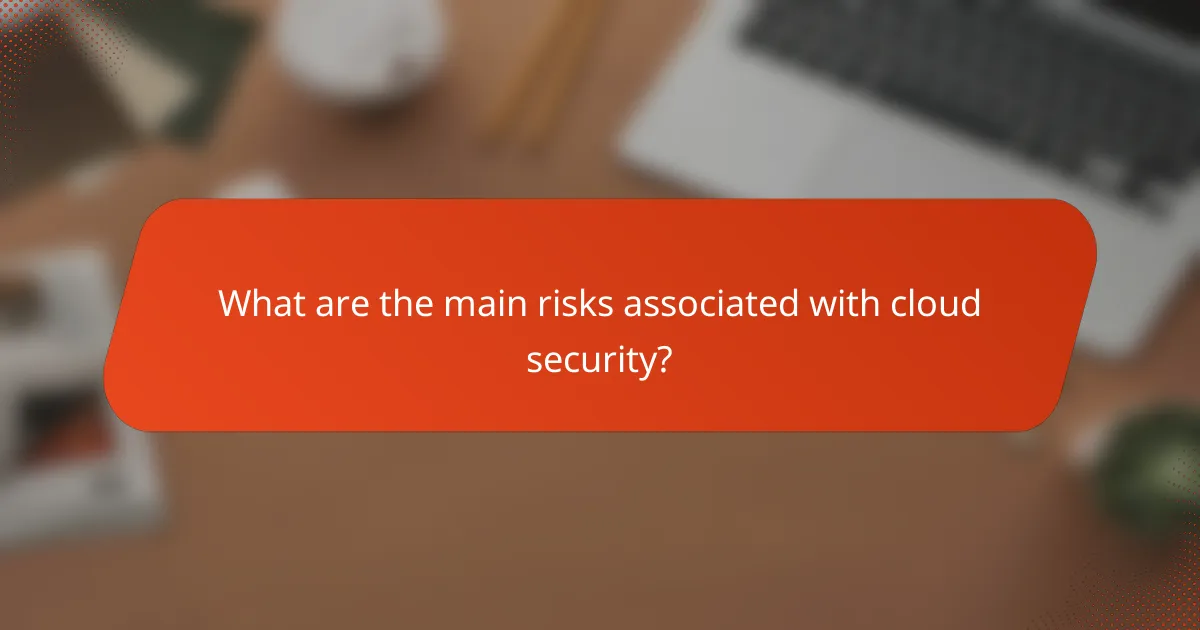
What are the main risks associated with cloud security?
The main risks associated with cloud security include data breaches, loss of data control, and account hijacking. Data breaches occur when unauthorized parties gain access to sensitive information. According to a 2021 report by IBM, the average cost of a data breach is $4.24 million. Loss of data control happens when organizations cannot manage their data once it is stored in the cloud. This often leads to compliance issues, especially with regulations like GDPR. Account hijacking involves attackers gaining unauthorized access to user accounts, which can lead to further security breaches. A study by Verizon found that 81% of hacking-related breaches involve stolen or weak passwords. Other risks include insecure APIs, insufficient due diligence, and insider threats, which further complicate cloud security.
What types of cloud security risks exist?
Cloud security risks include data breaches, account hijacking, insecure APIs, and insider threats. Data breaches occur when unauthorized individuals access sensitive information stored in the cloud. A report by the Identity Theft Resource Center noted that data breaches increased by 17% in 2021. Account hijacking happens when attackers gain access to user accounts, potentially leading to unauthorized actions. Insecure APIs can expose cloud services to attacks if not properly secured. Insider threats arise from employees misusing their access to cloud resources, which can lead to data leaks or sabotage. According to a 2020 report by Cybersecurity Insiders, 53% of organizations experienced an insider threat incident. These risks highlight the importance of robust cloud security measures.
How can data breaches impact organizations?
Data breaches can significantly impact organizations by compromising sensitive information. This can lead to financial losses due to fraud or theft. In 2021, the average cost of a data breach was $4.24 million, according to IBM. Organizations may also face legal consequences, including fines and lawsuits. Regulatory bodies may impose penalties for non-compliance with data protection laws. Additionally, data breaches can damage an organization’s reputation. Customers may lose trust and choose to take their business elsewhere. This can result in long-term revenue decline. Furthermore, organizations often incur costs related to incident response and recovery efforts. These factors collectively highlight the severe implications of data breaches on organizations.
What are the implications of inadequate cloud security compliance?
Inadequate cloud security compliance can lead to severe data breaches and financial losses. Organizations may face legal penalties due to non-compliance with regulations such as GDPR or HIPAA. These penalties can reach millions of dollars. Additionally, reputational damage may occur, leading to loss of customer trust. Companies may also experience operational disruptions, affecting service delivery. Furthermore, inadequate compliance increases vulnerability to cyberattacks. Research indicates that 60% of small businesses close within six months of a cyberattack. Overall, the implications of inadequate cloud security compliance are multifaceted and detrimental.
How can organizations identify cloud security risks?
Organizations can identify cloud security risks through comprehensive risk assessments. They should evaluate their cloud service provider’s security protocols. Regular audits and vulnerability assessments can uncover potential threats. Monitoring user access and activity helps detect unauthorized behavior. Implementing automated security tools can provide real-time alerts for anomalies. Compliance with industry standards, such as ISO 27001, guides risk identification. Employee training on security best practices enhances awareness of potential risks. These methods collectively strengthen an organization’s ability to identify and mitigate cloud security risks.
What tools are available for risk assessment in cloud environments?
Tools available for risk assessment in cloud environments include cloud security posture management (CSPM) solutions, vulnerability assessment tools, and compliance management platforms. CSPM tools, such as Prisma Cloud and Dome9, help identify misconfigurations and compliance violations. Vulnerability assessment tools like Qualys and Nessus scan for vulnerabilities in cloud resources. Compliance management platforms, including AWS Artifact and Azure Policy, assist in ensuring adherence to regulations. These tools provide continuous monitoring and reporting capabilities. They enhance cloud security by enabling organizations to proactively manage risks.
How often should organizations conduct cloud security audits?
Organizations should conduct cloud security audits at least annually. This frequency helps ensure compliance with regulations and standards. Regular audits identify vulnerabilities and assess security controls. Some organizations may require more frequent audits based on risk assessments. For example, industries like finance or healthcare may conduct audits quarterly. Continuous monitoring can also supplement periodic audits. Regular audits help maintain a strong security posture. The National Institute of Standards and Technology recommends regular assessments to manage risks effectively.
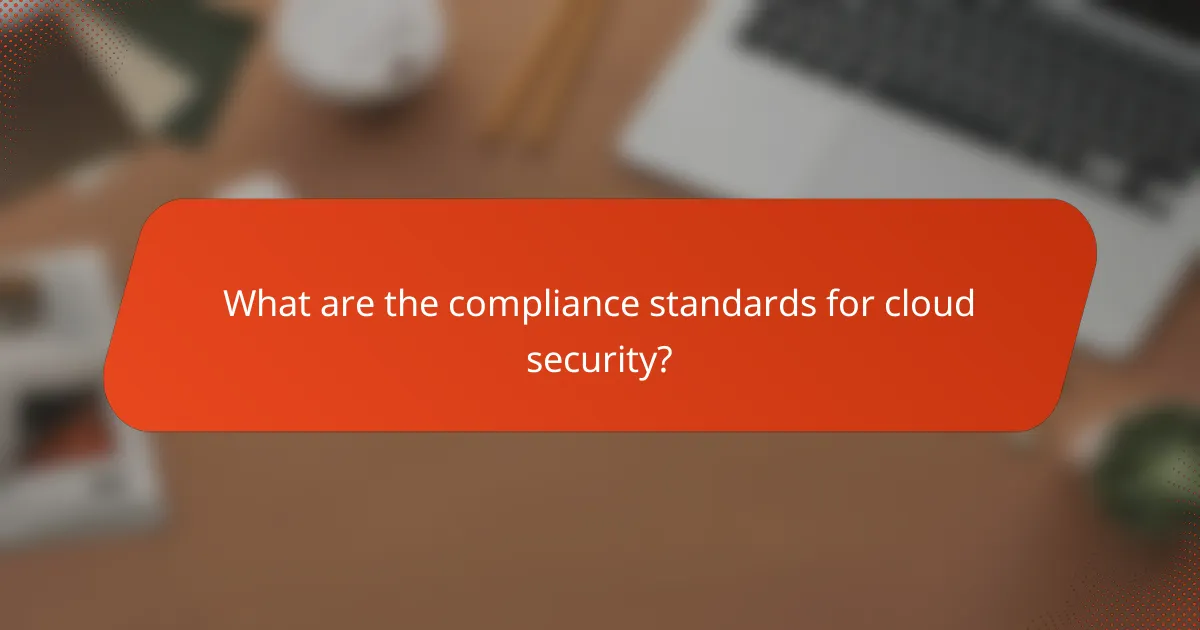
What are the compliance standards for cloud security?
Compliance standards for cloud security include frameworks such as ISO/IEC 27001, NIST SP 800-53, and GDPR. ISO/IEC 27001 outlines requirements for establishing, implementing, and maintaining an information security management system. NIST SP 800-53 provides a catalog of security controls for federal information systems and organizations. GDPR mandates data protection and privacy for individuals within the European Union. Other standards include HIPAA for healthcare data and PCI DSS for payment card information. These standards help organizations ensure data protection and regulatory compliance in cloud environments.
What are the most common compliance standards relevant to cloud security?
The most common compliance standards relevant to cloud security include ISO/IEC 27001, GDPR, HIPAA, and PCI DSS. ISO/IEC 27001 outlines requirements for an information security management system. GDPR governs data protection and privacy in the European Union. HIPAA sets standards for protecting sensitive patient health information in the United States. PCI DSS establishes security measures for organizations handling credit card transactions. These standards help organizations ensure data security and compliance in cloud environments.
How does GDPR affect cloud security practices?
GDPR mandates strict data protection measures that significantly impact cloud security practices. Organizations must ensure that personal data is processed securely in the cloud. This includes implementing encryption and access controls to protect data integrity and confidentiality. GDPR also requires data processors to have clear agreements with cloud service providers. These agreements must outline security responsibilities and compliance obligations. Additionally, organizations must conduct regular risk assessments to identify vulnerabilities in cloud environments. Non-compliance can lead to hefty fines, emphasizing the importance of adhering to GDPR standards. Thus, GDPR shapes cloud security by enforcing rigorous data protection protocols and accountability measures.
What is the significance of HIPAA in cloud security for healthcare?
HIPAA is significant in cloud security for healthcare as it establishes standards for protecting sensitive patient information. The Health Insurance Portability and Accountability Act mandates that healthcare organizations ensure the confidentiality, integrity, and availability of electronic protected health information (ePHI). Compliance with HIPAA requires implementing administrative, physical, and technical safeguards in cloud environments. These safeguards include encryption, access controls, and regular security assessments. Violations of HIPAA can result in severe penalties, including fines and legal action. Therefore, adhering to HIPAA guidelines is crucial for maintaining trust and ensuring patient privacy in cloud-based healthcare systems.
How can organizations ensure compliance with cloud security standards?
Organizations can ensure compliance with cloud security standards by implementing a robust security framework. This framework should include regular risk assessments to identify vulnerabilities. Organizations must also establish clear policies and procedures that align with industry standards. Training employees on security best practices is essential for maintaining compliance. Regular audits and reviews of security measures help ensure adherence to standards. Utilizing automated compliance tools can streamline monitoring processes. Additionally, organizations should stay updated on evolving regulations and standards. Engaging with third-party security experts can provide valuable insights and guidance.
What best practices should be followed for maintaining compliance?
To maintain compliance, organizations should implement regular audits and assessments. These audits help identify gaps in compliance and ensure adherence to regulations. Training employees on compliance policies is essential for fostering a culture of accountability. Documenting processes and changes provides a clear trail for compliance verification. Utilizing compliance management software can streamline tracking and reporting. Staying updated on regulatory changes is crucial for ongoing compliance. Engaging with legal and compliance experts ensures that the organization meets all requirements. Following these best practices can significantly reduce the risk of non-compliance and associated penalties.
How can compliance audits be effectively managed?
Compliance audits can be effectively managed by establishing a clear framework and consistent procedures. This includes defining the scope and objectives of the audit upfront. Regular training for staff involved in audits ensures they understand compliance requirements. Utilizing technology can streamline data collection and reporting processes. Developing a schedule for audits helps maintain regular oversight. Engaging external auditors can provide an unbiased perspective on compliance status. Documenting findings and corrective actions is essential for accountability. Continuous monitoring of compliance standards helps adapt to changing regulations. These practices contribute to a more efficient and effective compliance audit process.
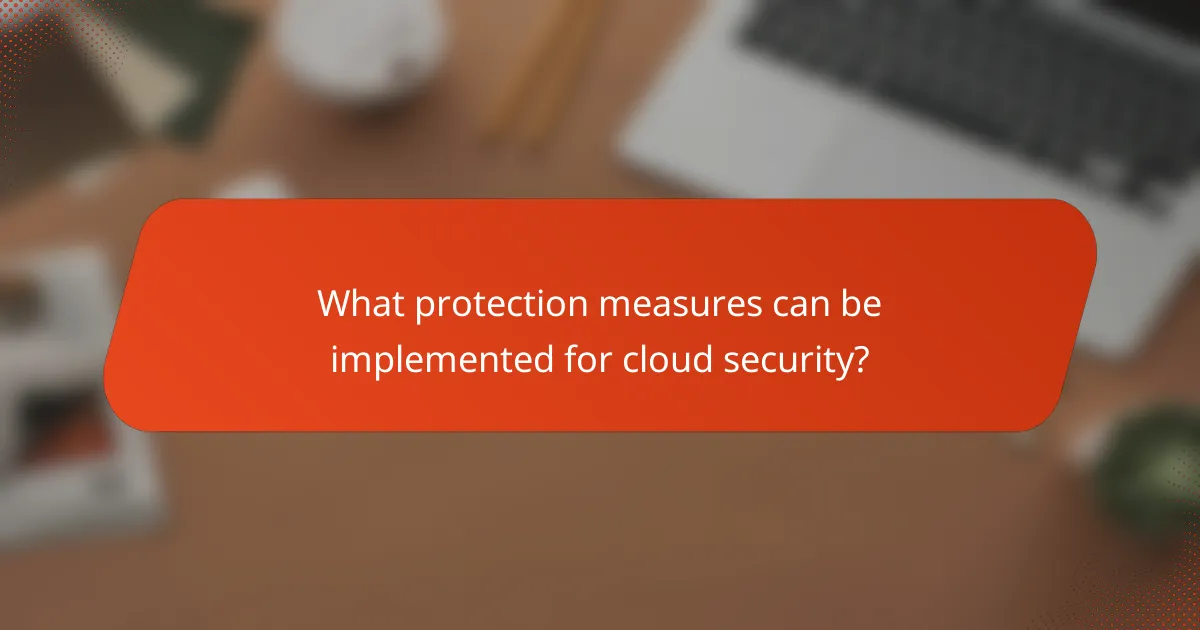
What protection measures can be implemented for cloud security?
Protection measures for cloud security include data encryption, access control, and regular security audits. Data encryption protects sensitive information both at rest and in transit. Access control ensures that only authorized users can access specific resources. Regular security audits help identify vulnerabilities and compliance with security standards. Multi-factor authentication adds an extra layer of security for user access. Intrusion detection systems monitor for unauthorized access attempts. Backup and disaster recovery plans ensure data availability in case of incidents. These measures collectively enhance the security posture of cloud environments.
What are the best practices for enhancing cloud security?
Implementing strong cloud security practices is essential for protecting sensitive data. First, use multifactor authentication to enhance access control. This adds an extra layer of security beyond just passwords. Regularly update and patch systems to address vulnerabilities. Keeping software current reduces the risk of exploitation. Encrypt data both in transit and at rest to safeguard it from unauthorized access. Data encryption ensures that even if data is intercepted, it remains unreadable. Conduct regular security audits and assessments to identify weaknesses. These evaluations help organizations stay ahead of potential threats. Implement a robust incident response plan to quickly address security breaches. Having a plan in place minimizes damage and recovery time. Lastly, train employees on security best practices. Educated users are less likely to fall victim to phishing attacks and other threats.
How can multi-factor authentication improve cloud security?
Multi-factor authentication (MFA) significantly enhances cloud security by requiring multiple forms of verification before granting access. This process adds an extra layer of protection beyond just a password. Even if a password is compromised, unauthorized access is still prevented if the second factor is not provided.
MFA typically involves something the user knows, like a password, and something the user has, such as a mobile device for a one-time code. According to a report by Microsoft, MFA can block 99.9% of account compromise attacks. This statistic underscores the effectiveness of MFA in securing sensitive data stored in the cloud.
By implementing MFA, organizations can mitigate risks associated with credential theft and phishing attacks. It is a proactive measure that aligns with compliance standards, enhancing overall cloud security.
What role does continuous monitoring play in cloud security?
Continuous monitoring plays a crucial role in cloud security by providing real-time visibility into the security posture of cloud environments. It enables organizations to detect vulnerabilities, threats, and anomalies as they occur. Continuous monitoring facilitates compliance with regulatory standards by ensuring that security policies are consistently enforced. It also aids in incident response by allowing for quicker identification and remediation of security breaches. According to a report by the Cloud Security Alliance, organizations that implement continuous monitoring significantly reduce their risk of data breaches. This proactive approach helps maintain the integrity, availability, and confidentiality of cloud resources.
How can organizations respond to cloud security incidents?
Organizations can respond to cloud security incidents by following a structured incident response plan. They should first identify the nature and scope of the incident. This involves assessing the affected systems and data. Next, organizations should contain the incident to prevent further damage. This may include isolating affected systems and disabling compromised accounts.
After containment, organizations should eradicate the root cause of the incident. This step ensures that vulnerabilities are addressed to prevent recurrence. Recovery follows, where organizations restore affected systems and data from backups. Continuous monitoring is essential during this phase to detect any lingering threats.
Finally, organizations should conduct a post-incident review. This review helps identify lessons learned and improve the incident response plan. According to the 2023 Cybersecurity Incident Response Survey, 85% of organizations that follow a structured response plan report improved outcomes in managing incidents.
What should be included in an incident response plan for cloud security?
An incident response plan for cloud security should include clear roles and responsibilities. Each team member must know their specific tasks during an incident. The plan should outline detection and analysis procedures. This ensures timely identification of security breaches. It must also detail containment strategies to limit damage. Effective communication protocols are essential for informing stakeholders. The plan should include recovery procedures to restore services. Finally, it must incorporate post-incident review processes for continuous improvement. These elements help organizations manage cloud security incidents effectively.
How can training and awareness reduce cloud security risks?
Training and awareness can significantly reduce cloud security risks by equipping employees with the knowledge to identify threats. Educated staff are less likely to fall victim to phishing attacks. Training programs can cover best practices for password management and data handling. Awareness initiatives can also inform employees about the importance of compliance with security policies. Regular training updates keep staff informed about evolving security threats. According to a study by the Ponemon Institute, organizations with security awareness programs experience 70% fewer security incidents. This demonstrates that informed employees contribute to a stronger security posture.
What are the key takeaways for improving cloud security?
Implementing strong access controls is essential for improving cloud security. This includes using multi-factor authentication to verify user identities. Regularly updating and patching systems helps protect against vulnerabilities. Conducting frequent security audits identifies potential weaknesses in cloud infrastructure. Encrypting sensitive data ensures that information remains secure during transmission and storage. Training employees on security best practices reduces the risk of human error. Monitoring cloud environments continuously detects suspicious activities in real time. Lastly, developing an incident response plan prepares organizations to respond effectively to security breaches.
Cloud security is the practice of safeguarding cloud computing environments from various threats, including data breaches and unauthorized access. This article explores the significance of cloud security for businesses, key threats, and essential protection measures such as encryption and access controls. It also examines compliance standards like GDPR and HIPAA, highlighting the implications of inadequate security practices. Furthermore, the article outlines best practices for enhancing cloud security, including regular audits, employee training, and incident response planning to mitigate risks effectively.



